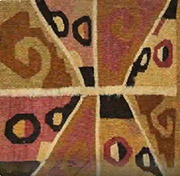Center, Textile Research

IX Jornadas Internacionales de Textiles Precolombinos y Amerindianos / 9th International Conference on PreColumbian and Amerindian Textiles, Museo delle Culture, Milan, 2022
Date of this Version
2024
Document Type
Article
Citation
Published in IX Jornadas Internacionales de Textiles Precolombinos y Amerindianos / 9th International Conference on Pre-Columbian and Amerindian Textiles, Museo delle Culture, Milan, 2022. (Lincoln, Nebraska: Zea Books, 2024)
DOI: 10.32873/unl.dc.zea.1621
Abstract
El presente trabajo expone un conjunto excepcional de piezas en técnica de tapicería encontrados en el cementerio de Topater, cercano al rio Loa, ubicado en el desierto de Atacama, Norte de Chile. Estos tejidos, objeto de investigaciones previas (Agüero 2000; Cases 2000; Sinclaire 2001), en conjunto con los anillados y los textiles con afelpados de mecha, constituyen la base de caracterización técnica del sitio. Las nuevas condiciones de almacenaje y reciente procesamiento de este material han permitido abarcar la totalidad de los textiles en tapicería, profundizando un estudio técnico estructural y de sistemas de representación asociados para desde allí replantear una revisión de sus posibles funciones, así como su relación con otros materiales de referencia y con textiles del período. El potencial representacional de la técnica de tapicería y la excelencia técnica de este conjunto tanto en su desarrollo cromático como estructural nos enfrenta a un corpus unitario que hacen de él un foco de gran valor e interés para la comprensión de esta tradición, constituyéndose en una referencia clave en el contexto del formativo en el norte de Chile.
The present work exposes an exceptional set of pieces in tapestry technique found in the Topater cemetery, near the Loa River, located in the Atacama Desert, Northern Chile. These tissues, the object of previous investigations (Agüero 2000; Cases 2000; Sinclaire 2001), together with the ringed and the textiles with plush wicking, constitute the basis for the technical characterization of the site. The new storage conditions and recent processing of this material have made it possible to cover all the upholstery textiles, deepening a detailed structural technical study to from there reconsider a review of its possible functions as well as its relationship with other reference materials with textiles of the period. The representational potential of the upholstery technique and the technical excellence of this set, both in its chromatic and structural development, confront us with a unitary corpus that makes it a focus of great value and interest for the understanding of this tradition, constituting a key reference in the context of the formative period in northern Chile.
Included in
American Material Culture Commons, Art and Materials Conservation Commons, Fiber, Textile, and Weaving Arts Commons, Indigenous Studies Commons, Latin American History Commons, Museum Studies Commons, Native American Studies Commons, Other History of Art, Architecture, and Archaeology Commons, Other Religion Commons


Comments
Copyright © 2024 Soledad Hoces de la Guardia Chellew & Ana María T. Rojas Zepeda.